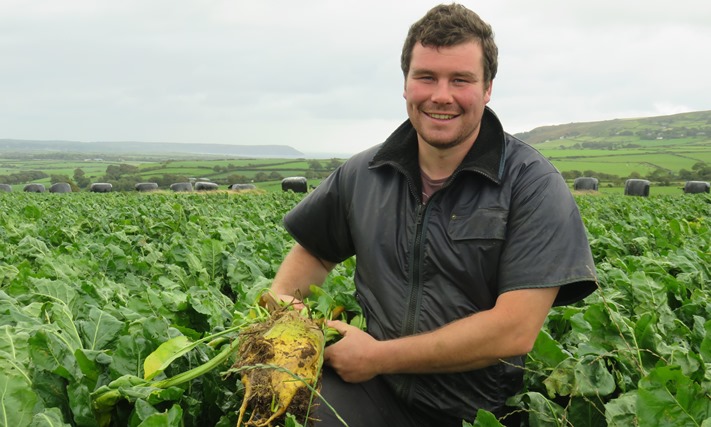Fodder beet takes pressure off winter housing
120 in-calf heifers will enjoy fodder beet for the first time this winter
Elgan Davies, farm manager at Cefn Amlwch, part of the Wynne Finch Farms company based on the Lleyn Peninsula in North Wales, will be outwintering 120 in-calf heifers for the first time this year on fodder beet.
Two 450-cow herds calve in spring and produce an average 5,000 litres/cow, based on a New Zealand-style grass-based system.
The cows stay out, weather permitting until 25 November and go back out to graze once they have calved from the beginning of February. While they are dry they stay in outdoor cubicles and eat self-feed silage. They calve in straw bedded yards close by.
“We wanted to take some of the pressure off the winter housing. Growing fodder beet on this dry, ten-acre field seemed like a good option,” Elgan explains.

Elgan with his Fodder Beet
“We can see the coast from the field and we have a good climate with relatively low rainfall at around five inches a year. So it should work well.”
The grass field was grazed by the cows in April, before being sprayed with Roundup and power-harrowed on 20 April. The field was limed and had urea, phosphate and potash applications, as well as a dressing of salt. Alpes fodder beet seed was precision drilled and the ground lightly rolled after. Pre-emergent herbicide was also applied. A contractor was used for all the fieldwork.
After a dry May and June, the crop started growing quickly when the summer rain came.
“We have invested a lot in this crop,” says Mr. Davies. “It is a bit like maize – you have to get everything right to achieve a good result.”
Fodder beet offers a highly palatable combination of sweet energy in the root with protein in the leaves. The low dry matter of 17% makes it ideal for grazing. The animals must be introduced slowly to the crop to avoid rumen upsets.
“There is a water trough in the centre of the field and bales of second cut silage have been placed around the outside,” Mr. Davies explains. “We shall offer straw and hay from a trailer to provide extra fibre to their diet.
“The field will probably be fenced to give them a daily section to eat – with one or even two emergency fencing blocks, so if they do break out they won’t have much to gorge on.”
In spring, whatever is left will be sprayed with Roundup and farmyard manure spread, before the soil is cultivated and made level, ready for a new grass reseed.
“The great thing about fodder beet is that it is flexible – it can be grazed, or if bad weather came, we could lift it and feed it by the cubicles. That is obviously more expensive, but at least there is that option, unlike some of the other forage crops such as kale.”
This article first appeared in British Dairying – November 2017
